The more I learn, the less I know. Finland’s story, as for any country, is varied and complex, and my understandings are necessarily incomplete. I stand at the fence and peer through its slats, conscious that I see only fragments, not the whole. Here is a second set of fragments from the King’s Road.
The Czar’s Fishing Lodge
The Imperial Fishing Lodge in Kotka, “the only building outside Russia once used and owned by the Emperor of Russia,” is undeniably an idyllic place. [Langinkoski Imperial Fishing Lodge Booklet 9] On his first visit there, the man who would become Czar Alexander III became enamored of the Langinkoski rapids on the estuary of the Kymijoki River. When he became Czar, he brought back his Danish wife, Dagmar, who is said to have loved the place as much as he did. In 1889, at the Lodge’s inauguration,
. . . the vessels of the imperial squadron fired thirty shots in his honour. . . . [That evening] the Emperor got up and unexpectedly presented a toast to Finland, after which he ordered the band to play the Pori March . . . [Lodge Booklet 6]
When at the lodge, the Emperor fished, chopped wood, and carried water from the river and the Empress cooked. She didn’t like to wash dishes, though, “so she left that to the servants.” [Lodge Booklet 6] Emperors and Empresses had license to do that sort of thing, though there were some in Russia who thought it unseemly for the imperial family to take its holidays “in the wilderness of Finland, eating nothing but fish soup.” [Lodge Booklet 9]
Meanwhile, back home in Russia, his fondness for the Grand Duchy of Finland notwithstanding, Alexander III busily rolled back the liberal policies of his father, Alexander II.
. . . reactionary where his father had been liberal, Alexander governed from three principles—orthodoxy, autocracy, and narodnost, or belief in the Russian people. [Glenda Dawn Goss, Sibelius: A Composer’s Life and the Awakening of Finland, Loc 873]
Though he continued his predecessor’s practice of honoring Finland’s autonomy, Alexander III was a strong proponent of “Russification.”
[His] political ideal was a nation containing only one nationality, one language, one religion and one form of administration; and he did his utmost to prepare for the realization of this ideal by imposing the Russian language and Russian schools on his German, Polish and other non-Russian subjects, by fostering Eastern Orthodoxy at the expense of other religions, by persecuting Jews and by destroying the remnants of German, Polish and Swedish institutions in the outlying provinces. [citation]
Two years after his death, “a memorial stone for the Emperor was unveiled at Langinkoski.”
The translation of the text on the plaque mounted on the stone reads: “Alexander III, Builder of Peace, enjoyed rest and recreation here under the aegis of a faithful people from 1888 to 1894. The people of Kymi and Kotka erected this memorial plaque.” During the Civil War of 1918 following the independence of Finland, the memorial stone was shot at and vandalised, and there were attempts to remove it. The traces of vandalism have been retained as a memento of one phase in the history of Finland. [citation]
Strömfors Iron Works
Thirty miles west of the Czar’s Fishing Lodge, the Strömfors Iron Works sits in Ruotsinpyhtää at the westernmost junction of the Kymijoki River. As the town changed hands, its name changed, too. A potted summary at Wikipedia tells some of the tale:
The area of Ruotsinpyhtää was originally part of Pyhtää. After the Treaty of Åbo in 1743 the border between Sweden and [the] Russian Empire was drawn on the Ahvenkoski rapid, dividing Pyhtää between the two states. Due to this the western side became known as Ruotsinpyhtää (Swedish Pyhtää). In 1744 Jakob Forsell (later af Forselles) and Anders Nohrström bought the local ironworks, which was renamed Strömfors after their surnames. In 1817 Strömfors became the official Swedish name for the municipality.
Among the well-preserved wooden buildings is an octagonal wooden church with an altarpiece by the esteemed Finnish painter Helene Schjerfbeck. It’s the only altarpiece she painted, and it turns out she got the commission because she put in the lowest bid. The guide who told me smiled wryly, for the painting is now an extremely valuable work of art. Another artwork, valuable in its own way, is a small statue sitting on a shelf, purchased by the church from the impoverished parishioner who’d carved it.
What I loved most about the wooden church were its simple lines and the way light flooded in. I was reminded of the Russian garrison church at Suomenlinna, from which the Finns, on achieving their independence, removed the onion domes. “[T]he tower was rebuilt square. . . . The arched, curved bays, kokoshniks and other orthodox ornamentation were removed and the walls were plastered smooth.” [citation] The feeling of the Suomenlinna church, as of the wooden church in Ruotsinpyhtää, is of a great weight lifted—of light and air.
Porvoo
For our King’s Road exploration, we might have chosen to stay in Porvoo but for two things: we wanted a base in a more rural setting, and we’d been alerted that Porvoo’s proximity to Helsinki meant that, “in the summer at least, you’re hardly likely to be alone.” [Rough Guide to Finland Loc 2342] That advice turned out to be right for us, but Porvoo is nonetheless a lovely “wooden town.” One of six towns in Finland founded in the Middle Ages, Porvoo is the only one that retains its medieval street plan. [citation]
Most of its buildings, though, are of more recent vintage. The Danes burned Porvoo to the ground in 1508; in 1708 the Russians followed suit. In 1760, the Great Fire of Porvoo destroyed two-thirds of its houses; it’s said that the fire began with a pot of fish soup left unattended on a stove. [Porvoo Official City Guide 23] The people of Porvoo rebuilt their homes after the Great Fire, and safety measures since imposed have assured their presence today. [citation]
Among those homes is Lukiokuja 4, where Johan Ludvig Runeberg, a Swedish-speaking Finn, took up residence in 1837 when he first arrived in Porvoo.
The main outlines of this doughty icon’s life are well known: how the great fire in Turku that destroyed the university there destroyed his hopes for a career; how in Helsinki he was unable to obtain a position at the Imperial Alexander University; how he spent most of his adult life as a gymnasium (high school) teacher in the town of Porvoo. . . . [Goss Loc 468]
By the time Runeberg died, “the honouring of his memory assumed almost religious proportions.” Jean Sibelius was among those who paid homage. As a young boy, he “accompanied his mother on a pilgrimage to visit Runeberg in person . . . . [and] journeyed again to Porvoo to lay flowers at the poet’s newly dug grave.” [Goss Loc 472]
Among other works, Runeberg wrote the text for what became Finland’s national anthem, Vårt land (Maamme in Finnish). The Pori March, the performance of which Czar Alexander III had ordered at his Finnish Fishing Lodge, bore a Runeberg text, as well. After Finland’s independence from Russia in 1917, signaling the utter failure of the Russification program in Finland, the Finnish Defense Force adopted the Pori March as its official marching song.
(This is the second of two posts of Scenes from the King’s Road. The first post may be found here.)
Listening List
Sibelius “set more poems of Runeberg to music than those of any other bard.” [Goss Loc 504]
On Spotify, for Sibelius songs set to Runeberg texts, sung by Anne Sofie von Otter, click here.
On YouTube:
Norden (Northland), from Sibelius’s 6 Songs, Op.90 (1917)
The text, in Swedish and English, may be found here.
Flickan kom ifrån sin älsklings mote (The girl came from meeting her lover), from Sibelius’s 5 Songs, Op. 37 (1900-2) (With grateful thanks to Anneli for introducing me to Flickan kom ifrån sin älsklings mote and many other Sibelius songs.)
The text, in Swedish and English, may be found here.
In 1933, Marian Anderson met and sang for Jean and Aino Sibelius at their home, Ainola. Anderson wrote at the time that, when she finished singing, Sibelius, “with tears in his eyes, came over and embraced me.”
<<<>>>
Credits: The quotations may be found at the links indicated in the post. As always on the blog, the photographs, unless otherwise accredited, are mine.


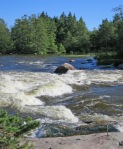
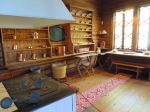
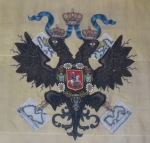
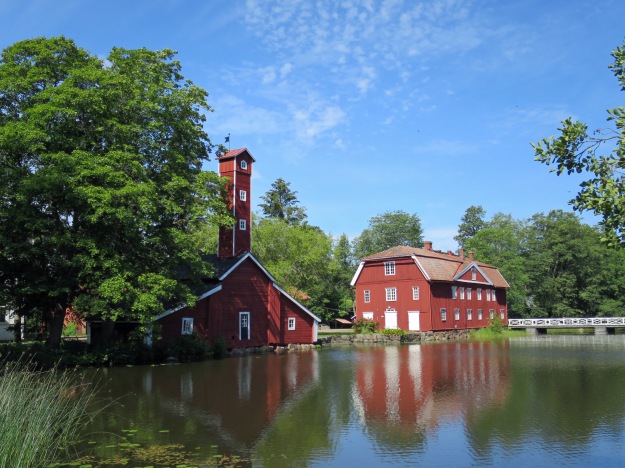
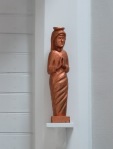
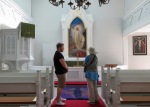
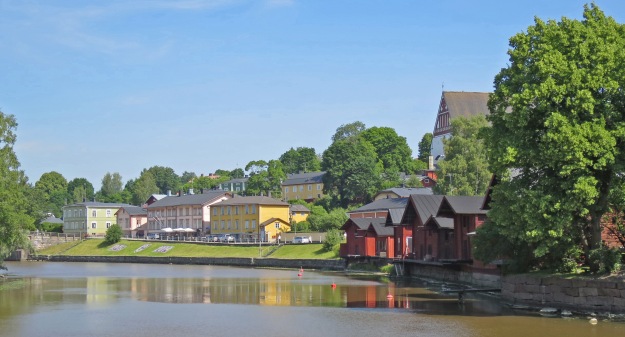
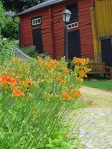
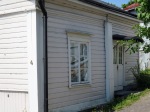
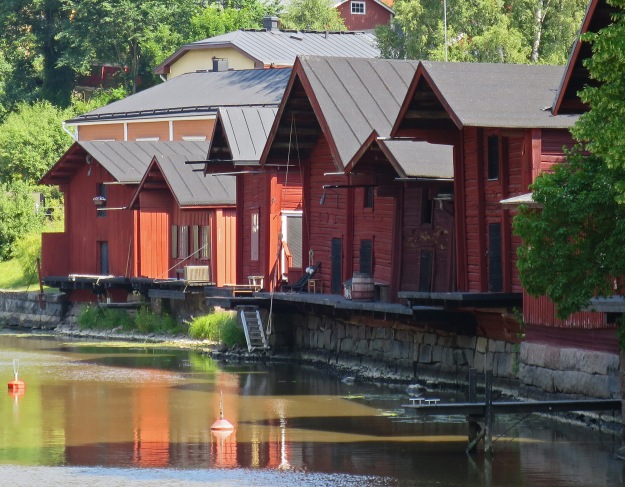
Excellent post. Many places which You presented here are my favorite places.
Sartenada: Thank you for stopping by. So pleased you enjoyed the post!
Oh the blue skies and the light on the still waters (evocative shot of the rather beautiful iron works especially) – how I long for the north in summer. By the time I return it will be the ever-shortening days of autumn. A Swedish friend of mine has just returned from the archipelago – week after week, she said, of perfect temperatures and clear skies. It must all seem a bit of a dream to you now.
My way into the Sibelius songs was an LP of Flagstad with orchestra: slightly solid, but so majestic. Amazing the differences between those in Swedish (the majority) and the Finnish few. What an amazing language it can be as set to music. And so unlearnable!
David: You know, our first thought was to go to the archipelago, but we soon discovered this is where everyone goes in the summertime and couldn’t find a suitable place. I’m just as glad, as I suspect that would have been more for the out-of-doors and wouldn’t have given us so much of the history and culture of Finland.
As for the “Finnish few”–I had no idea until we went on this trip that Finland’s language was not the least allied to Scandinavian languages. We were completely lost trying to decipher it. I can’t explain this at all, but when I look at words in Finnish on the page, I somehow “see” them as music.
Here’s a lovely poem by Eeva-Liisa Manner in Finnish and English, just for fun:
Teoreema
Proosa olkoon kovaa, se herättäköön levottomuutta.
Mutta runo on kaiku joka kuullaan, kun elämä on mykkää:
vuorilla liukuvat varjot: tuulen ja pilvien kuva,
savun kulku tai elämän: kirkas, hämärä, kirkas,
hiljaa virtaava joki, syvät pilviset metsät,
hitaasti maatuvat talot, lämpöä huokuvat kujat,
hauraaksi kulunut kynnys, varjon hiljaisuus,
lapsen pelokas askel huoneen hämäryyteen,
kirje joka tulee kaukaa ja työnnetään oven ali,
niin suuri ja valkea että se täyttää talon,
tai päivä niin jäykkä ja kirkas että voi kuulla
miten aurinko naulaa umpeen aution sinisen oven.
Eeva-Liisa Manner
Theorem
Let prose be hard, let it provoke unease.
But the poem is an echo that is heard when life is mute:
shadows gliding on mountains; the image of wind and cloud,
the passage of smoke or life: bright, dusky, bright,
a river flowing silent, deep cloudy forests,
houses mouldering slowly, lanes radiating heat,
a worn-down threshold, the stillness of shadow,
a child’s timorous step into the darkness of the room,
a letter that comes from afar and is pushed under the door,
so big and white that it fills the house,
or a day so stiff and bright that you can hear
how the sun nails shut the abandoned blue door.
Not suggesting for a moment that you should have gone there. She has friends/family with summer homes, and hotels are few and far between. Gotland (and Faro) might be worth considering for a future trip – I want to spend longer in Visby than we did on the way back from the ‘Bergman experience’.
The third movement of Kullervo sets the Finnish language so memorably – 5/4, a lot of it, which goes to show that Finnish is like Russian in being ideal for that lovely metre.
Looking forward to reading more in September.
I always learn so much over here, Susan. I didn’t know that Sibelius set Swedish-language songs to music, and I was quite taken with “Flickan kom ifrån sin älsklings möte.” The first time through I just listened, after which I read the words and then listened again. What a turn the story takes between the first two verses and the rest.
Steve: I am so pleased you were taken with “Flickan,” and yes, doesn’t the story (and the music with it) take quite a turn? Sibelius’s first language, as it turns out, was Swedish, and, as David notes, most of the songs he set were in Swedish, too. Languages are a complicated matter in Finland. As a prime example, Runeberg, Finland’s national poet, was a Swedish speaker and wrote in Swedish.
I was interested in this: “The feeling of the Suomenlinna church, as of the wooden church in Ruotsinpyhtää, is of a great weight lifted—of light and air.” Your impression reminds me of my second trip to London. I had designed for myself a tour of Christopher Wren parish churches, and my enduring memory is of the light pouring into so many of them. White interiors and beautiful wooden floors and seating had a bit of the flavor of the photo you show here.
And oh, the fires. The towns in Sweden from which my paternal grandparents departed in the early 1900s had suffered multiple fires. Another tale I heard from my dad, which I can’t confirm in the slightest, is that my grandmother (born in 1895) was determined to come to America partly because of her admiration for Jenny Lind (who died in 1887). It is a fact that Grandma never got over her obsession with Jenny Lind, whose voice I imagine as beautiful as Marian Anderson’s. She always grieved that there weren’t any recordings to enjoy.